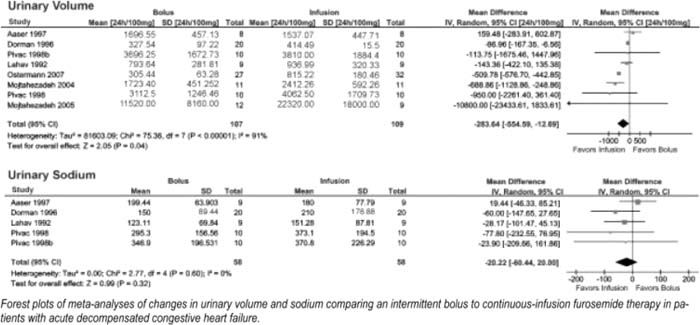Background:
For treatment of acute decompensated congestive heart failure (CHF), intravenous loop diuretics are usually administered as intermittent bolus injections. However, these bolus injections can cause significant hemodynamic effects because of fluctuations in intravascular volume, urine output, and serum electrolytes. Continuous infusion of loop diuretics may have similar or greater diuresis without adverse hemodynamic effects. We, therefore, performed a meta‐analysis of randomized controlled trials to compare effectiveness of continuous‐infusion with intermittent loop diuretic therapy in patients with acute decompensated CHF.
Methods:
PubMed, EMBASE, and the Cochrane Central Register of Controlled Trials databases were searched from the inception of these databases up to September 2009. Clinical trials that randomized patients (crossover and parallel) with decompensated CHF to continuous‐infusion and intermittent bolus furosemide treatment and reported outcomes on urinary volume and urinary sodium were included. References of the retrieved articles were hand‐searched for additional relevant studies. Data on study characteristics, quality, and outcomes were abstracted independently by 2 investigators, and differences were resolved with mutual consensus Results were pooled using a random‐effects model.
Results:
We identified 8 trials enrolling 192 patients that fulfilled our inclusion criteria. A majority of the patients were male (55%) and older than 50 years of age (mean age = 64 years). Data on 24‐hour urine volume was reported for 107 patients in 7 trials. Continuous infusion furosemide therapy was associated with a moderate and significantly larger increase in 24‐hour urinary volume per 100 mg of furosemide compared with the intermittent bolus group (mean difference = −283.64 mUL/100 mg/24 h, 95% Cl = −554.59 to −12.69; P = 0.04). Data on 24‐hour urinary sodium were reported for 58 patients in 5 trials. Continuous‐infusion furosemide therapy was associated with a modest and statistically insignificant change in 24‐hour urinary sodium compared with the intermittent bolus group (mean difference = −20.22 mmol/24 h, 95% Cl= −60.44 to 20.00; P = 0.32).
Conclusions:
Continuous‐infusion furosemide therapy resulted in a moderately significant change in 24‐hour urine volume when compared with an intermittent bolus regimen. However there was no significant change in 24‐hour urinary sodium in the 2 groups.
Author Disclosure:
M. Amer, none; J. Adomaityte, none; R. Qayyum, none.

